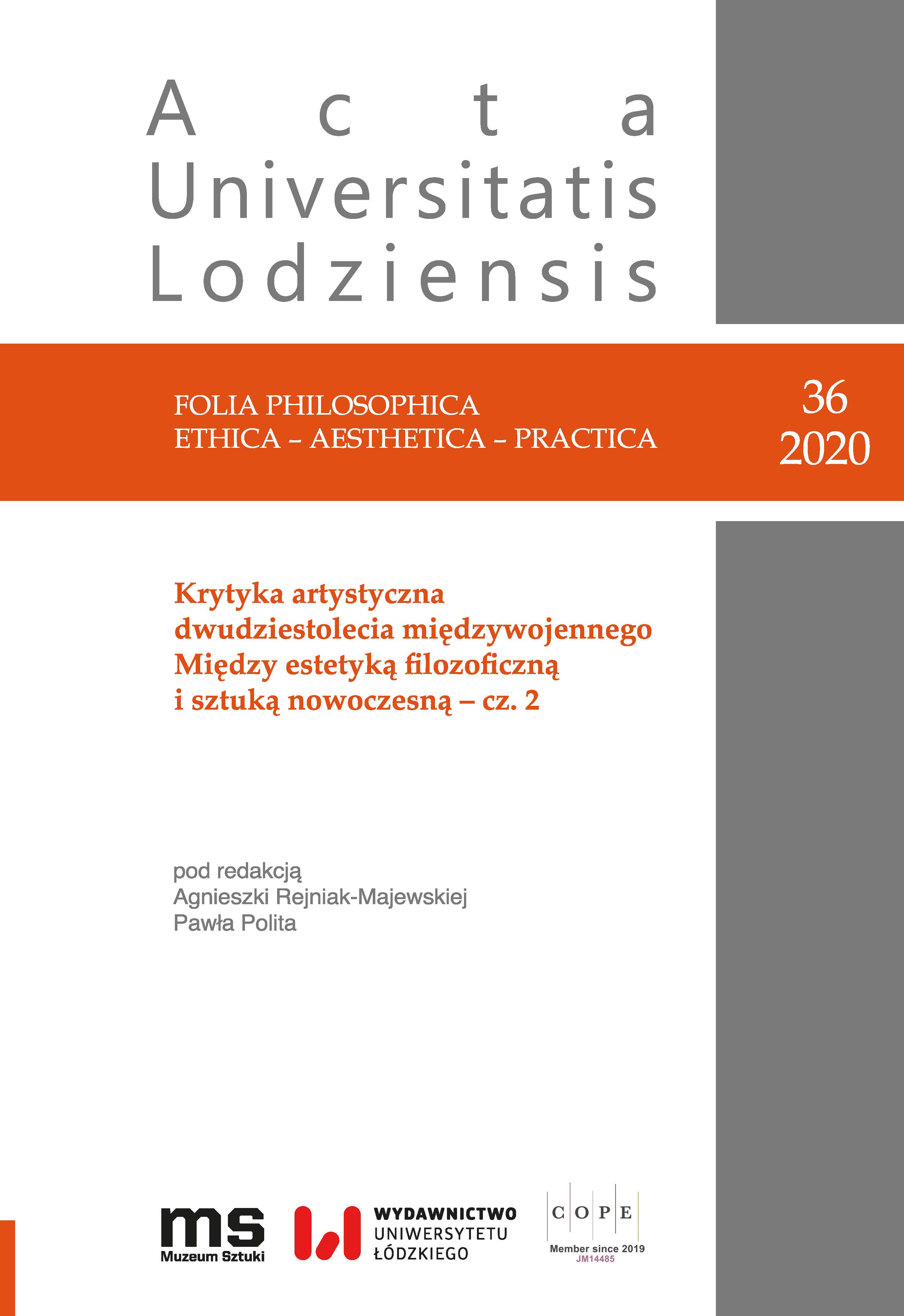Reaching for the Heart of the Matter. Interdependence of Forms of Art and Life in Debora Vogel’s Essays
DOI:
https://doi.org/10.18778/0208-6107.36.02Keywords:
Debora Vogel, Lu Märten, Jakob von Uexküll, modern art, abstraction and objectivity, banality, art and lifeAbstract
In this article, Debora Vogel (1900–1942) is depicted as one of the most important art critics and theorists of the 1930s. In Polish as well as in Yiddish she designed a set of ideas both elitist and, at the same time, most tightly related to everyday-life in which art was considered essential to life and „life” itself – in the sense of a banal and eternal ballad. Behind this thought we see, quite substantially, the art of Marc Chagall. His paintings served Vogel as proof of the main thesis of avant-gardism that content equals form. The equal status of life and art is researched by Vogel through the lens of up-to-dateness – something she comprehended as a construction of reality in her work, not as an art manifesto or an expression of political views. Starting from Hegel’s aesthetics, the Lemberg-based intellectual moved on to materialist dialectics and became a follower of Lu Märten, the pioneer of Marxist aesthetics. Vogel’s poetics of life and her conceptions of art were versatile, rooted in philosophy, i.a. in Jakob von Uexküll’s theory of subjective perception. The latter’s conception of a functional circle contributing to a turn in the perception of the avant-garde, is reviewed in the article. Finally, several questions are put forth referring to the relevance of Henri Bergson’s and Georg Simmel’s thoughts for Vogel’s comprehension of art.
References
Behne Adolf, Biologie und Kubismus, „Der Sturm” 1915, nr 11/12, s. 68–71.
Google Scholar
Behne Adolf, Neues Bauen Neues Wohnen, Hesse & Becker Verlag, Leipzig 1930.
Google Scholar
Behne Adolf, Schriften zur Kunst, red. Cornelia Briel, Gebr. Mann Verlag, Berlin 1998.
Google Scholar
Behne Adolf, Zur neuen Kunst, Verlag Der Sturm, Berlin 1915.
Google Scholar
Bergson Henri, Schopferische Entwicklung, Eugen Dietrichs, Jena 1912.
Google Scholar
Croce Benedetto, Lebendiges und Totes in Hegels Philosophie, C. Winter, Heidelberg 1909.
Google Scholar
Degler Janusz, Debora Vogel i Witkacy, „Ogród” 1994, nr 1 (17), s. 208–212.
Google Scholar
Elias Norbert, Gesammelte Schriften I: Frühschriften, red. Reinhard Blomert i in., Suhrkamp, Frankfurt a.M. 2002.
Google Scholar
Endell August, Vom Sehen. Texte 1896–1925 über Architektur, Formkunst und „Die Schönheit der großen Stadt”, red. Helge David, Birkhäuser, Basel–Berlin–Boston 1995.
Google Scholar
Europa Almanach. Malerei, Literatur, Musik, Architektur, Plastik, Bühne, Film, Mode, red. Carl Einstein, Paul Westheim, Gustav Kiepenheuer Verlag, Potsdam 1925.
Google Scholar
Jakob von Uexküll: A paradigm for biology and semiotics, red. Kalevi Kull, wydanie specjalne pisma „Semiotica” 2001, nr 134.
Google Scholar
DOI: https://doi.org/10.1515/semi.2001.013
Kapuściński Grzegorz, O metaforze przestrzennej w komunikowaniu. Między kulturą a naturą, „Miscellanea Anthropologica et Sociologica” 2014, nr 15 (1), s. 71–83.
Google Scholar
DOI: https://doi.org/10.5604/20842937.1122743
Köhnen Ralph, „Wahrnehmung wahrnehmen“. Die Poetik der „Neuen Gedichte“ zwischen Biologie und Phänomenologie: von Uexküll, Husserl und Rilke, w: Rilkes Paris 1920–1925. Neue Gedichte, red. Erich Unglaub, Jörg Paulus, Wallstein Verlag, Göttingen 2010, s. 196–211.
Google Scholar
Märten Lu, Wesen und Veränderung der Formen/Künste. Resultate historisch materialistischer Untersuchungen. Der Taifun-Verlag, Frankfurt a.M. 1924.
Google Scholar
Mildenberger Florian, Umwelt als Vision. Leben und Werk Jakob von Uexkülls, Franz Steiner Verlag, Stuttgart 2007.
Google Scholar
Montaże. Debora Vogel i nowa legenda miasta, red. Andrij Bojarov, Paweł Polit, Karolina Szymaniak, wyd. Muzeum Sztuki w Łodzi, Łódź 2017.
Google Scholar
Rem Michał, O „nowej rzeczowości” w Polsce, „Europa” 1929, nr 2, s. 85–86.
Google Scholar
Roh Franz, Nach–Expressionismus. Magischer Realismus. Probleme der neuesten europäischen Malerei, Klinkhardt & Bierman, Leipzig 1925.
Google Scholar
Schulz Bruno, Księga listów, red. Jerzy Ficowski, Słowo/Obraz Terytoria, Gdańsk 2008.
Google Scholar
Simmel Georg, Lebensanschauung. Vier metaphysische Kapitel, Druckner & Humblot, München–Leipzig 1918.
Google Scholar
Surreale Sachlichkeit. Werke der 1920er und 1930er–Jahre aus der Nationalgalerie, red. Kyllikki Zacharias, Nationalgalerei, Staatliche Museen zu Berlin, Berlin 2016.
Google Scholar
Szymaniak Karolina, Być agantem wiecznej idei. Przemiany poglądów estetycznych Debory Vogel. Kraków 2006.
Google Scholar
Uexküll von Jakob, Die Lebenslehre, Müller & Kiepenheuer, Potsdam–Zürich 1930.
Google Scholar
Uexküll von Jakob, Theoretische Biologie, Paetel, Berlin 1920.
Google Scholar
Uexküll von Jakob, Umwelt und Innenwelt der Tiere, Springer, Berlin 1909.
Google Scholar
Vogel Debora, Akacje kwitną. Montaże, posł. Karolina Szymaniak, Austeria, Kraków 2006.
Google Scholar
Vogel Debora, Der mut cu zajn ajnzam, „Der Morgen” 1930, nr 1223, s. 7–8.
Google Scholar
Vogel Debora, Die Geometrie des Verzichts. Gedichte, Montagen, Essays, Briefe, tłum. oraz red. Anna M. Misiak, Arco Verlag, Wuppertal 2016.
Google Scholar
Vogel Debora, Forma i tematyka w sztuce Chagala, w: Almanach i Leksykon Żydostwa Polskiego, Herman Dicker, Lwów 1938, t. 2 Temat i forma w sztuce Chagalla. Próba krytyki estetycznej. Także w: „Ogród” 2003, nr 1–2 (21–22), s. 238–251.
Google Scholar
Vogel Debora, Kilka uwag o współczesnej inteligencji, „Przegląd Społeczny” 1936, nr 6, s. 114–121.
Google Scholar
Vogel Debora, Legenda współczesności w literaturze dziecięcej, „Przegląd Społeczny” 1934, nr 3, s. 41–46.
Google Scholar
Vogel Debora, Lektura w okresie dojrzewania, „Przegląd Społeczny” 1928, nr 6, s. 26–28.
Google Scholar
Vogel Debora, Marc Chagall (Z okazji 50–lecia urodzin), „Jednodniówka. Żydowski Uniwersytet Ludowy we Lwowie” 1937, s. 19–20.
Google Scholar
Vogel Debora, Mieszkanie w swej funkcji psychicznej i społecznej, „Przegląd Społeczny” 1932, nr 8–9, s. 208–217.
Google Scholar
Vogel Debora, Motyw codzienności w literaturze dziecięcej, „Przegląd Społeczny” 1933, nr 11, s. 235–240.
Google Scholar
Vogel Debora, O kształtowaniu nastawienia życiowego, „Przegląd Społeczny” 1928, nr 3, s. 12–15.
Google Scholar
Vogel Debora, Z wystaw Związku zawodowego Artystów Plastyków we Lwowie, „Sygnały” 1939, nr 61, s. 8.
Google Scholar
Vogel Debora, Zagadnienie indywidualności i możliwości indywidualizacji w okresie dojrzewania, „Przegląd Społeczny” 1928, nr 7, s. 9–20.
Google Scholar
Downloads
Published
How to Cite
Issue
Section
License

This work is licensed under a Creative Commons Attribution-NonCommercial-NoDerivatives 4.0 International License.












